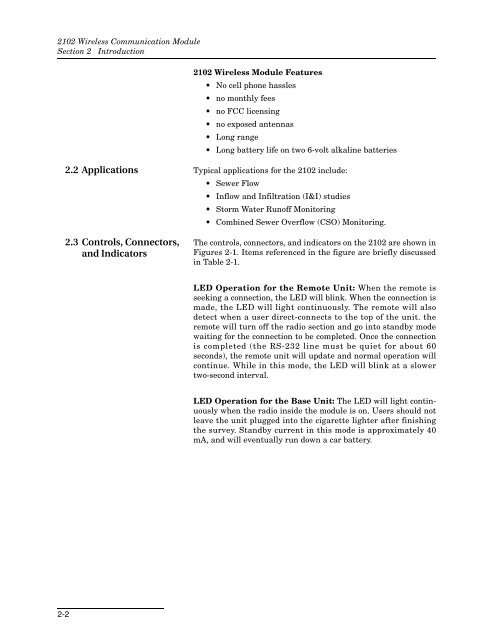2102 Wireless Module - Isco
2102 Wireless Module - Isco
2102 Wireless Module - Isco
You also want an ePaper? Increase the reach of your titles
YUMPU automatically turns print PDFs into web optimized ePapers that Google loves.
<strong>2102</strong> <strong>Wireless</strong> Communication <strong>Module</strong><br />
Section 2 Introduction<br />
<strong>2102</strong> <strong>Wireless</strong> <strong>Module</strong> Features<br />
• No cell phone hassles<br />
• no monthly fees<br />
• no FCC licensing<br />
• no exposed antennas<br />
• Long range<br />
• Long battery life on two 6-volt alkaline batteries<br />
2.2 Applications Typical applications for the <strong>2102</strong> include:<br />
• Sewer Flow<br />
• Inflow and Infiltration (I&I) studies<br />
• Storm Water Runoff Monitoring<br />
• Combined Sewer Overflow (CSO) Monitoring.<br />
2.3 Controls, Connectors,<br />
and Indicators<br />
The controls, connectors, and indicators on the <strong>2102</strong> are shown in<br />
Figures 2-1. Items referenced in the figure are briefly discussed<br />
in Table 2-1.<br />
LED Operation for the Remote Unit: When the remote is<br />
seeking a connection, the LED will blink. When the connection is<br />
made, the LED will light continuously. The remote will also<br />
detect when a user direct-connects to the top of the unit. the<br />
remote will turn off the radio section and go into standby mode<br />
waiting for the connection to be completed. Once the connection<br />
is completed (the RS-232 line must be quiet for about 60<br />
seconds), the remote unit will update and normal operation will<br />
continue. While in this mode, the LED will blink at a slower<br />
two-second interval.<br />
LED Operation for the Base Unit: The LED will light continuously<br />
when the radio inside the module is on. Users should not<br />
leave the unit plugged into the cigarette lighter after finishing<br />
the survey. Standby current in this mode is approximately 40<br />
mA, and will eventually run down a car battery.<br />
2-2
















